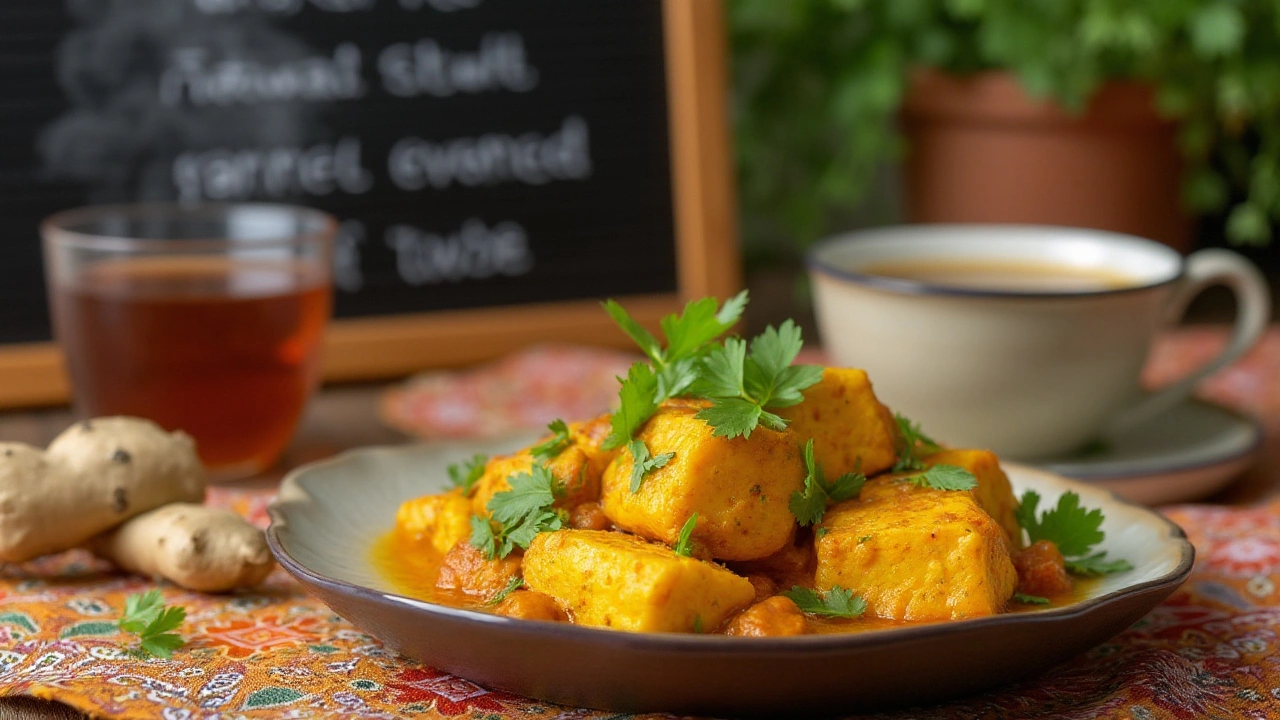9 Dec 2024
- 0 Comments
There's something about the creamy texture and delightful flavor of homemade paneer that makes it a beloved choice for many cuisines. But what happens when every indulgence is met with an uncomfortable sensation in your belly?
Many people find themselves puzzled by stomach pain after enjoying paneer, especially when made at home. It can be a nagging discomfort that keeps you away from one of your favorite dishes. There could be an array of reasons behind this unexpected belly protest.
From potential lactose intolerance to the digestive habits we practice, we'll dive into why your tummy might be complaining and what you can do to soothe it. This article unravels the mystery behind your paneer-induced bellyache and offers practical tips to keep enjoying the dish you love so much.
- Understanding Paneer Making
- Common Causes of Digestive Discomfort
- Lactose Intolerance Explained
- Tips for Easier Digestion
- Remedies to Soothe Stomach Pain
- Creating Delicious, Digestive-Friendly Paneer Recipes
Understanding Paneer Making
Paneer, a staple in many Indian households, is a versatile ingredient that can transform a simple meal into a heartwarming feast. But what makes homemade paneer so special? It's the freshness, the control over the ingredients, and the satisfaction that comes with creating something from scratch. Making paneer at home relies on a simple chemical reaction. The process begins with milk—usually cow or buffalo—slowly heated to just under its boiling point. At this temperature, an acid like lemon juice or vinegar is added, causing the milk proteins to coagulate. These proteins, mainly casein, begin to bind together, forming the soft, creamy substance that will later become paneer.
Once the milk separates into curds and whey, the mixture is poured through a cheesecloth or muslin. The curds are allowed to drain, and the liquid, called whey, can be kept for other culinary uses, like making bread or as a soup base, since it contains nutrients like protein and vitamins. After draining, the curds are pressed under a weight for a few hours to remove excess water, resulting in a firm block of paneer ready for slicing or cubing. The simplicity of making paneer can be deceptive; slight variations in temperature, the amount of acid used, or the duration of pressing can alter the texture and taste significantly.
Understanding the science behind this process is essential for reliable results. The heat ensures even coagulation, while the choice of acid affects flavor subtly.
Chef Manjit Gill once said, "Paneer is more than food; it's an emotion. The way you treat the milk determines the paneer's personality." This speaks volumes about the importance of each step in paneer making. Such knowledge allows home chefs to tweak the process, adjusting the heat, experimenting with different acids, or even adding herbs to the curds before pressing, resulting in a personalized cheese that reflects individual taste.Paneer is often lauded for its nutritional benefits. It's packed with protein and calcium, making it an excellent choice for vegetarians seeking to meet their dietary needs. However, it's vital to consume paneer in moderation, especially if one's trying to manage weight, as it's also rich in fat. Knowing your ingredients—like whether the milk is full-cream or skim—can help tailor paneer's nutritional content to fit dietary preferences. Should you encounter trouble with stomach pain after consuming your homemade paneer, revisiting these basic making steps is an excellent starting point to see if something has gone amiss that might be affecting its digestibility. This attention to detail raises your paneer's quality, making every dish that features it a standout on your dining table.
Common Causes of Digestive Discomfort
When the flavors of homemade paneer leave you with an uncomfortable stomach, it's natural to wonder what might be going on under the surface. In this section, we'll explore various reasons why you might experience stomach pain after indulging in this beloved dish. One common culprit is the lactose intolerance that many people develop without realizing. Paneer, being a dairy product, contains lactose – a type of sugar found in milk. Some people lack sufficient lactase, an enzyme required to break down lactose during digestion, leading to discomfort. Another reason could be the richness of the paneer itself, which can be challenging for some stomachs to handle if they're not used to high-fat content meals. Such richness might trigger not only bloating but also a sluggish digestion process that leaves you feeling uneasy post-meal.
Beyond the typical lactose issues, the way paneer is prepared or combined with other foods could contribute to your digestive troubles. For instance, spices commonly paired with paneer in various cuisines may be irritants to sensitive stomachs. Spices like chili powder or pepper, albeit flavorful, can increase acidity levels and exacerbate symptoms like heartburn or indigestion. The portion size is another aspect to consider; overeating is an easy mistake to make when faced with a delicious, creamy dish. Consuming large quantities of rich foods can overwhelm the digestive system, making it work harder to break down the overload, leading to pain or discomfort. Adjusting portion sizes and incorporating paneer into balanced meals can mitigate some of these issues.
Food freshness is another critical factor seldom addressed. Sometimes the quality of milk used in homemade paneer can directly affect its digestibility. Fresh, high-quality milk generally results in a smoother paneer that's less likely to irritate your stomach. Additionally, if the paneer is stored for too long, it may start fermenting or spoil, which not only affects the flavor but may also cause an upset stomach due to bacterial growth.
There is also the stress factor, which is often overlooked. A relaxed meal is not just better enjoyed but better digested. Eating in a state of stress can significantly impact how your body processes food, sometimes leading to discomfort after meals. It may sound whimsical, but enjoying your paneer in a calm environment and taking the time to savor each bite can help your digestive system in processing this rich meal more efficiently.
"A healthy gut thrives not just on what you eat, but how you enjoy it," suggests Dr. Elena Martinez, a renowned dietitian specializing in digestive health. "Taking time with your meals can drastically improve your digestive experience."And when should you be concerned enough to seek medical advice? Occasional discomfort might not be worrisome, but if you experience consistent or severe pain, weight changes, or other symptoms post-consumption, it’s wise to consult with a healthcare professional. This ensures you rule out more serious issues such as allergies or gastrointestinal disorders. Paying attention to how your body reacts and keeping a food diary can provide clarity and help you adjust your diet accordingly.

Lactose Intolerance Explained
Lactose intolerance is a common digestive problem that results when the body is unable to properly digest lactose, a sugar found in milk and dairy products. The condition arises due to a deficiency of lactase, an enzyme produced in the small intestine. Without enough lactase, the body can't break down lactose effectively, leading to symptoms such as bloating, diarrhea, and stomach pain.
Many people with lactose intolerance find that eating foods like homemade paneer, which typically contain lower amounts of lactose than milk, is less problematic. However, when consumed in significant amounts or along with other dairy products, even paneer can trigger symptoms. It's also important to note that the severity of symptoms can vary considerably between individuals, influenced by the amount of lactose consumed and individual tolerance levels.
A study published in the 'Journal of Dairy Science' highlighted that as much as 70% of the world’s population may experience some form of lactose malabsorption after infancy. This emphasizes that lactose intolerance is not a rare anomaly but a widespread condition. People often underestimate its prevalence, misconstruing the symptoms for other ailments. According to the National Institutes of Health (NIH), lactose intolerance is most prevalent in East Asian adults, affecting up to 90% in some populations.
"Understanding lactose intolerance begins with recognizing that it’s a natural part of the human body for many. It’s not an allergy but a normal biological reaction that’s widespread across populations." – Dr. Anna Lee, Nutritionist.Feeling discomfort after eating paneer might indicate lactose intolerance. To confirm it, keeping a food diary to track when symptoms occur can be helpful. Sometimes, lactose intolerance is temporary, resulting from factors like intestinal diseases or infections. Thus, understanding your own digestive responses is crucial.
For those who are intolerant, there are several strategies to manage symptoms. These include consuming smaller amounts of dairy, choosing lactose-free alternatives, or supplementing with lactase enzyme tablets before meals that contain dairy. Adapting your diet doesn't mean you have to eliminate all dairy; it's about finding balance and replacement options that work for you. Adding more fiber-rich foods can also aid digestion, helping to mitigate the effects of lactose consumption.
Tips for Easier Digestion
Enjoying homemade paneer shouldn't come at the cost of discomfort. To help your stomach process this delightful cheese smoothly, a few simple strategies can be adopted in your culinary routine. One crucial approach is to pair paneer with foods that aid in digestion. Including fiber-rich vegetables such as spinach, carrots, or peas in your meals can help your digestive system manage the richness of the cheese. These vegetables are not only nutritious, but they also provide bulk that encourages the efficient movement of food through your stomach. By diversifying the components of your meal, you can balance the richness and ease digestion.
Another valuable technique involves moderating your portions. Sometimes, it's not what you eat but how much you eat. Eating large quantities of paneer might overwhelm your digestive system, leading to discomfort. Moderate portions allow your body to process the cheese efficiently without overloading your system. It's a simple yet effective way to continue enjoying your favorite foods without ill effects. In the words of renowned nutritionist Marion Nestle:
"Moderation in all things, especially with rich foods, is key to maintaining a balanced diet and a happy gut."Staying hydrated is also essential in aiding digestion. Water helps the process of breaking down food more effectively, allowing your digestive organs to operate at optimum levels. You can improve your water consumption by sipping a warm glass of water with meals, which is known to aid digestion. Of course, remember not to drink too much water in one go to prevent diluting stomach acids necessary for digestion.
Incorporating probiotics into your diet is another effective strategy. Probiotics are live microorganisms that can promote a healthy balance in your gut flora and enhance your digestive health. Including fermented products like yogurt, kefir, or sauerkraut along with your paneer can bolster digestive processes and improve your stomach’s ability to handle dairy.
Ensure that the way you prepare and cook your paneer contributes positively to digestion. Opt for boiling or lightly sautéing instead of deep frying, which can add unnecessary grease and strain the stomach. Spices like cumin, ginger, and turmeric are not only flavorful but are also well-known for facilitating digestion. Adding these to your paneer dish can help breakdown complex proteins more efficiently.
Lastly, consider giving yourself a gentle post-meal walk. Physical movement encourages the natural movement of food through your digestive system, preventing buildup and discomfort. A simple 10-15 minute walk after meals can help the digestive process immensely. By incorporating these simple yet effective tips, you can enjoy your favorite homemade paneer without worry, cultivating harmony between indulgence and comfort.

Remedies to Soothe Stomach Pain
For those who experience discomfort after enjoying the creamy delight of homemade paneer, fear not, as there are several ways to ease this pesky pain. Understanding how to handle digestive distress can make all the difference in your culinary indulgence. Here, we explore practical and natural remedies that might help calm your stomach and let you savor your favorite dish without a second thought.
Your journey begins with the palette of herbal teas known for their soothing properties. Ginger tea, with its powerful anti-inflammatory effects, helps in easing gastrointestinal discomfort. Studies have shown that ginger speeds up stomach emptying, which assists in reducing bloating and gas. Similarly, peppermint tea is a wonderful remedy as well. Rich in menthol, it relaxes the digestive tract muscles and can alleviate symptoms of irritable bowel syndrome, including stomach pains. A warm cup of these teas might just be your best friend during a belly rut.
Incorporating digestive enzymes into your routine might also bring some relief. These enzymes can aid in breaking down the proteins found in paneer, thus improving digestion and reducing abdominal pain. You can find these naturally in foods like pineapples and papayas, which contain bromelain and papain, respectively.
According to Dr. Michael Greger, a physician renowned for his work in nutrition, supplementing meals with food high in natural enzymes can significantly aid the digestive process.Another effective approach is simply taking a short walk post-meal. Physical activity, even in its mild form, aids in stimulating digestion and improving bowel movement. Walking helps move food through the digestive tract more quickly, which can prevent the build-up of gas and discomfort.
Hydration is another cornerstone of preventing stomach pain. Adequate water intake supports digestion by helping to dissolve nutrients and move them smoothly through your intestines. Sipping water before and after your paneer meal can prevent constipation and bloating, providing a smoother gastronomic passage.
Lastly, it's worth practicing mindful eating. Taking your time to chew paneer thoroughly and savor each bite not only enhances your eating experience but also aids digestion. This simple act ensures that your digestive system doesn't get overwhelmed by large chunks, making it easier for your stomach to process the meal.
Creating Delicious, Digestive-Friendly Paneer Recipes
When you’re a fan of paneer but wary of the bellyaches that sometimes follow, finding the right recipe can change everything. Addressing the issue starts with understanding the potential culprits behind digestive discomfort. Once we pinpoint these, the process of concocting digestive-friendly paneer dishes becomes not only manageable but also enjoyable. Homemade paneer, with its freshness and purity, can be transformed into a delightful experience that keeps your tummy happy and satisfied. It’s about playing with textures, flavors, and ingredients that aid digestion while preserving the paneer’s luscious appeal.
To start, consider using plant-based milk alternatives that are low in lactose. Almond or coconut milk can deliver a unique twist to the traditional paneer, making it easier on the stomach. Additionally, incorporating spices such as fennel, ginger, and turmeric not only adds depth to the flavor but aids in digestion too. These spices are renowned for their carminative properties and can significantly enhance the digestibility of dishes.
As Dr. Amy Shapiro, a renowned nutritionist, often remarks, "Spices have the power to transform our digestion, bringing about more than just flavor. They offer a digestive relief so unmistakable that they become a must in every meal."Simplifying the preparation process with lighter cooking techniques can also play a crucial role. Grilling or baking homemade paneer rather than frying reduces the heaviness of the meal, making it kinder on your digestive system. Keep the flavors fresh and vibrant—a squeeze of lemon can brighten the dish without overwhelming your palate, and most importantly, it won’t weigh you down. Fresh herbs like mint and cilantro can also aid digestion, providing a refreshing counterbalance to the rich texture of the paneer.
Here’s a step-by-step guide to crafting a delightful and digestible dish:
- Start with fresh, preferably organic ingredients. This means fresh milk alternatives, a pinch of selected spices, and aromatic herbs that can lift the dish.
- Consider steaming the paneer before adding it to your dish to make it even softer and more digestible.
- Use a gentle hand with spices. Start with the basics: a hint of cumin, a dash of fennel, balanced by the natural sweetness of cinnamon can often work wonders.
- Experiment with introducing fiber-rich vegetables like spinach or asparagus, which help in easing digestion while bulking up the meal.
- Try combining paneer with quinoa or millet, grains known for their easy digestibility and nutritional benefits, to create a balanced meal.
- Serve with a side of a light, tangy yogurt sauce spiked with a splash of lemon and a dusting of mint, an age-old remedy for digestive issues.
The goal is to embrace what makes paneer wonderful while curating a meal that's both delicious and gentle on your digestive system. By approaching each dish with creativity and mindfulness, you can enjoy your beloved paneer without the worry of stomach pain—redefining this cheese as a wholesome, comfort-filled delight worthy of the dining table.
